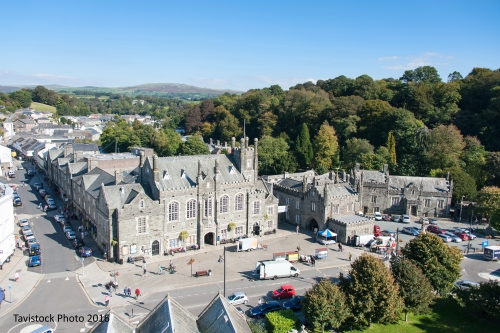 Tavistock - Gateway to Cornwall and West Devon Mining World Heritage sites.
Tavistock - Gateway to Cornwall and West Devon Mining World Heritage sites.
Straddling the fast-flowing river Tavy, below the western edge of Dartmoor, Tavistock stands in the heart of an area of tremendous natural beauty and is a classic West Country Market Town. The population of Tavistock, as estimated in June 2018, was approximately 12,500.
The old streets radiate from Bedford Square and contain shops for every taste and need. Within easy walking distance of the car parks and bus station you can find an eclectic mix of small independent shops, including delicatessens famous throughout the South West. Venture behind the Town Hall to discover the award winning and historic Pannier Market. The Town's Market used to be held in Bank Square, now a car park but was replaced in 1860 by a stone-built covered Pannier Market. The Market bustles with activity on most days of the week. Award winning hotels, restaurants and cafés cater for all tastes.
Situated just five minutes from the town centre, between the River Tavy and the canal, you will find The Meadows. This beautiful and peaceful park is a tranquil haven with attractive walks, children's play area and Trim Trails.
There are many leisure and sporting activities available in and around the Town including live entertainment and cinema at The Wharf Arts Centre, swimming at Meadowlands Leisure Pool, golf, cricket, football, tennis and being the birthplace of Sir Francis Drake, bowling.
Tavistock is a lively and attractive Market Town, which wears its historic links with pride.
For more information on local attractions, things to see and do in Tavistock and our local Visitor Information Centre please use the following links:
Tavistock Heritage Trust Website - Visitor Information Centre
History
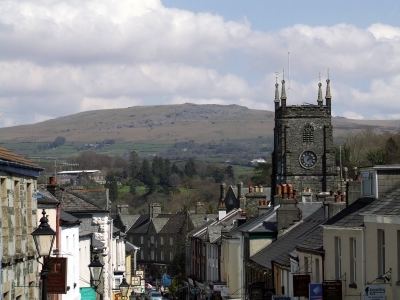
Tavistock is frequently referred to as the “Western Gateway to Dartmoor”. Its history dates from around 800 AD when an Iron Age Fort was recorded as “Tavy-stoc”. In the 10th Century a Benedictine Abbey was founded there, and on its dissolution by Henry VIII the lands went to the Russell family, who as the Dukes of Bedford have maintained a close interest in the town ever since.
The Town, which had received its Market Charter from Henry I in 1105, developed from its wool trade, enjoying the monopoly to manufacture woollen cloths known as Tavistock Kersies. The wool trade flourished for many years, and the town prospered from its weekly markets, being the centre of a large farming district.
It also had the distinction of being one of the Stannary Towns where all the mined metal was weighed, stamped and assessed for duty. From the 12th Century considerable quantities of tin were mined, but latterly tin-mining was in decline. By 1850 the mining industry was booming again in this area with extraction of copper from the famous Devon Great Consols Mine. This was once the richest source of copper in Europe, and the relics of old workings are common, some standing stark and awesome against the sky, some softened by a cloak of ivy, others lost to the sight of all but the most determined searcher.
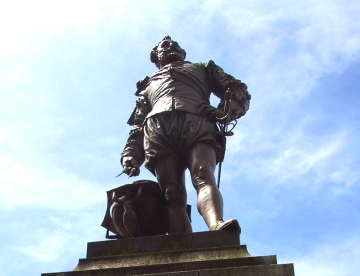 In 1542 Tavistock's most famous son was born at a farm at Crowndale just down-stream on the Tavy - he was to become Sir Francis Drake. He left home to become apprenticed on a ship trading in the Channel and in 1567 Drake and Hawkins sailed out of Plymouth on a slave-trading voyage to the West Indies, and first tangled with the Spaniards. By 1588 when he helped the Lord High Admiral of England to defeat the Spanish Armada, as immortalised by that famous game of bowls on Plymouth Hoe, he had been knighted by Elizabeth I for his services to the country (and her Treasury). He made his home at Buckland Abbey close to Tavistock. On Plymouth Road is Edgar Boehm's Statue of Drake, erected by the 9th Duke of Bedford in 1883. Around its granite pedestal are bas reliefs depicting scenes from the life of Drake, the first Englishman to circumnavigate the world. Although more famous than its Tavistock counterpart, the Statue of Drake on Plymouth Hoe is a copy of the original Tavistock model, and does not possess these bas reliefs. For more information on the story of the Statue please click on the link to The Story of Drake's Statue page - Link to the Story of Drake's Statue Page. Drake died during his West Indies Expedition in 1594, being buried at sea.
In 1542 Tavistock's most famous son was born at a farm at Crowndale just down-stream on the Tavy - he was to become Sir Francis Drake. He left home to become apprenticed on a ship trading in the Channel and in 1567 Drake and Hawkins sailed out of Plymouth on a slave-trading voyage to the West Indies, and first tangled with the Spaniards. By 1588 when he helped the Lord High Admiral of England to defeat the Spanish Armada, as immortalised by that famous game of bowls on Plymouth Hoe, he had been knighted by Elizabeth I for his services to the country (and her Treasury). He made his home at Buckland Abbey close to Tavistock. On Plymouth Road is Edgar Boehm's Statue of Drake, erected by the 9th Duke of Bedford in 1883. Around its granite pedestal are bas reliefs depicting scenes from the life of Drake, the first Englishman to circumnavigate the world. Although more famous than its Tavistock counterpart, the Statue of Drake on Plymouth Hoe is a copy of the original Tavistock model, and does not possess these bas reliefs. For more information on the story of the Statue please click on the link to The Story of Drake's Statue page - Link to the Story of Drake's Statue Page. Drake died during his West Indies Expedition in 1594, being buried at sea.
William Browne, the poet, was born in Tavistock. He was educated at Tavistock Grammar School around 1600. Although his style of poetry is now unfashionable, Browne undoubtedly influenced other poets, including Milton and Keats. On the exterior wall of the Parish Church may be seen an inscription to this Son of Tavistock; born in Tavistock 1590.
The year 1626 saw an outbreak of the plague in Tavistock, and 600 people died. The Westcountry had become Puritan by this time, and suspicious of the pro-Catholic King Charles. The Fourth Earl of Bedford was also of Puritan persuasion, and Tavistock was represented int Parliament by John Pym whose portrait hangs in the Town Hall and who played a large part in the drawing up of the Petition of Rights. During the Civil War Devon was predominantly for Parliament, and in November 1642 the Royalist Army from the Duchy of Cornwall captured the Town. There was a great deal of skirmishing around Tavistock, as the Royalists tried to capture Plymouth. At one time the town changed hands three times in a month.
In 1644 King Charles himself came to Tavistock, and stayed in the house of the Glanville family in Pym Street. He left after a week having failed to subdue Plymouth, and his son later visited in 1645. He immortalised the Town by declaring in later years whenever anyone mentioned the weather," if it is raining anywhere in my kingdom it will be raining in Tavistock" In 1646 the siege of Plymouth was raised, and Tavistock was recaptured by the Parliamentarian New Model Army for good.
In 1682, partly to try to curb the power of the Bedfords, Charles II created Tavistock as an incorporated Borough, with Mayor and Corporation. Revoked later by James II, this was the first attempt at some form of self-government for the residents. Later that century the Earl of Bedford was created Duke of Bedford and the title Marquis of Tavistock was given to the heir. The burgesses and freeholders of the town elected one of their number each year to be the Portreeve; the highest local government office. The title comes from the Anglo--Saxon Port (for Market Town) and Reeve (for steward). The Fourth Duke of Bedford presented the Town with a matched pair of silver maces in 1761, and these are still carried in procession at all civic events before the Town Mayor.
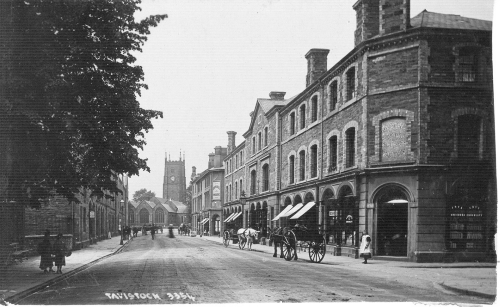 During the French wars of the 18th and 19th Century Tavistock was a parole-town; and captured French officers were allowed to be billeted in the town and roam within strict limits. Still to be seen on the Tavistock to Whitchurch Road is the Honour Oak which marked the boundary in 1814.
During the French wars of the 18th and 19th Century Tavistock was a parole-town; and captured French officers were allowed to be billeted in the town and roam within strict limits. Still to be seen on the Tavistock to Whitchurch Road is the Honour Oak which marked the boundary in 1814.
A daily mail coach linked Tavistock with London via Exeter. It arrived at the Bedford Hotel at 11am each morning and left for London at 3pm. At this time there was a Methodist revival in the Westcountry, and the industrial revolution began to affect the town. Mining increased, a canal to Morwellham was constructed, and in 1859 the Great Western Railway came. A programme of slum clearance and redevelopment began under the control of the Seventh Duke of Bedford, which left the town much as it is seen today.
Tavistock itself is unique for its green stone buildings (Hurdwick Stone from a local quarry), which have a subtle charm. Many of them were built with stone taken from the Abbey when it was demolished after the Dissolution.
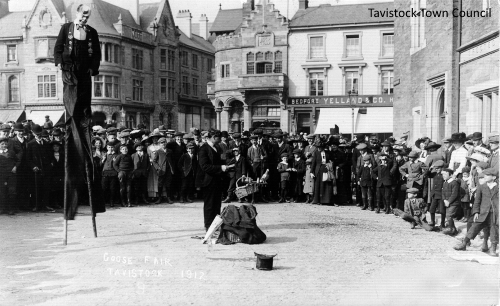 The Town's focal point is Bedford Square, flanked by the Parish Church (St Eustachius) and the Town Hall, built in 1859 as part of the re-development carried out by Francis, the Seventh Duke of Bedford, whose statue stands outside the Guildhall, erected in 1848. The re-development was paid for largely from the huge royalties the Duke was receiving from mining operations on his Estates.
The Town's focal point is Bedford Square, flanked by the Parish Church (St Eustachius) and the Town Hall, built in 1859 as part of the re-development carried out by Francis, the Seventh Duke of Bedford, whose statue stands outside the Guildhall, erected in 1848. The re-development was paid for largely from the huge royalties the Duke was receiving from mining operations on his Estates.
Nearby are most of the existing remains of the Abbey. All are scheduled as Ancient Monuments. The most picturesque is the Court Gate, an archway leading from Bedford Square to Guildhall Square. The archway houses the Museum and the Subscription Library - one of the oldest private libraries in Devon. The Arch stands on the site of the main entrance to the great courtyard of the Abbey.
A ruined Gatehouse in the garden of the Vicarage in Plymouth Road is known as Betsy Grimbal's Tower the traditional story is that a jealous monk or soldier murdered a woman called Betsy Grimbal there.
A section of the Abbey's cloister walling still stands in the Churchyard across the road and some of the 13th Century foundation work of the Abbey Church (including a tiled pavement) can also be seen there. Some of the outer wall of the Abbey and the Monks' Stillhouse (where medicines were distilled) runs along the bank of the Tavy between Abbey Bridge and The Meadows. The quiet, secluded river path is known as the Abbey Walk.
Visit the Tavistock Local History Society website for more information on the history of Tavistock.
The Parish Church
Dominating the town centre, Tavistock's beautiful Parish Church is dedicated to St. Eustachius, the Roman Officer who was martyred. It was dedicated in 1318, but most of the building dates from the 15th Century, although the tower is older.

The Town Hall
One of the most attractive features of Bedford Square is the Town Hall the embattled and pinnacled building, completed in 1860, has a beautifully vaulted, beamed ceiling and will seat approximately 500 people. The main function room houses a number of portraits of Tavistock's noted dignitaries, including the Bedford family, Sir Francis Drake and Lord John Russell.
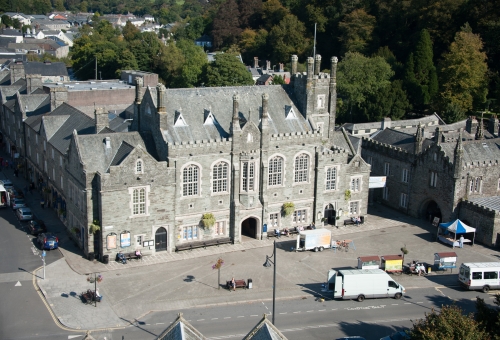
The Pannier Market
The Pannier Market is hidden behind the Town Hall. A market has been running in the town, without a break, since 1105 when the town was granted a Market Charter by Henry I. Inside you will find an enormously diverse range of products and services, and it really is one of the 'must sees' in Tavistock.
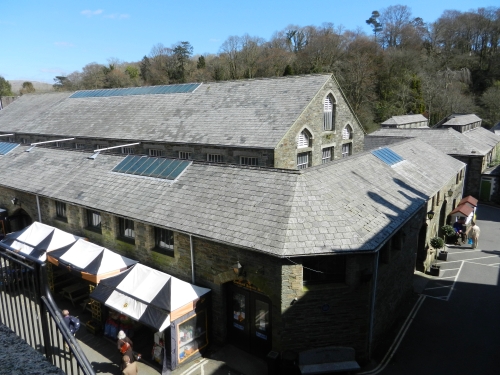
The Tavistock Coat of Arms
 What does it all mean?
What does it all mean?
The coat of arms is displayed on a shield, with the earliest known representation in 1684. In the language of heraldry the description or blazon reads:
"Per pale. gules and azure; a fleece banded; a chief, dexter a lion passant gardent, sinister a fleur-de-lys, all or."
Pale is the central line of the shield.
The coloured backgrounds on either side of the pale are gules (red) for military bravery and azure (blue) for loyalty.
Fleece banded refers to the wool trade, one of the major sources of Tavistock's wealth.
Chief refers to the uppermost part of the shield.
On the right-hand side (viewer's left), Dexter the lion's leg is raised to show motion, passant, and his face is turned as he is watchful, gardant.
On the left-hand side (viewer's right) of the shield, sinister, the fleur-de-lys can be interpreted as a symbol of a French connection or of Our Lady, who shared the dedication of Tavistock Abbey with St. Rumon.
All three symbols appear in "or", meaning gold.
The Town Motto:
CRESCIT SUB PONDERE VIRTUS
VIRTUE FLOURISHES UNDER A BURDEN'

